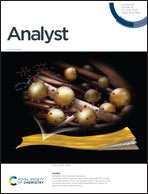Sensitive detection of extracellular hydrogen peroxide using plasmon-enhanced electrochemical activity on Pd-tipped Au nanobipyramids†
Abstract
The fabrication of electroactive nanostructures with high electron concentration and specific electron transport is crucial for electrochemical sensing. In this study, a plasmon-enhanced electrochemical sensor has been developed for the detection of extracellular hydrogen peroxide (H2O2) from cancer cells, utilizing Pd-tipped Au nanobipyramids (PTA NBPs) as the electrocatalysts. Plasmonic PTA NBPs were synthesized by depositing Pd nanoparticles onto the tips of Au nanobipyramids (Au NBPs). Under excitation of localized surface plasmon resonance (LSPR), the PTA NBPs generate high-energy electron–hole pairs (e−/h+) on their surface. The generated electrons (e−) significantly enhance the electrochemical reduction of H2O2. Based on this, a plasmon-enhanced H2O2 electrochemical sensor is constructed with high sensitivity (986.57 μA mM−1 cm−2), low detection limit (0.02 μM), wide linear range (0.1 μM to 980 μM), and good stability and repeatability. Moreover, this sensor also enables the measurement of extracellular H2O2 derived from cancer cells (MCF-7), highlighting its potential applications in cellular biology and biomedical research.

- This article is part of the themed collection: Analyst HOT Articles 2023


 Please wait while we load your content...
Please wait while we load your content...